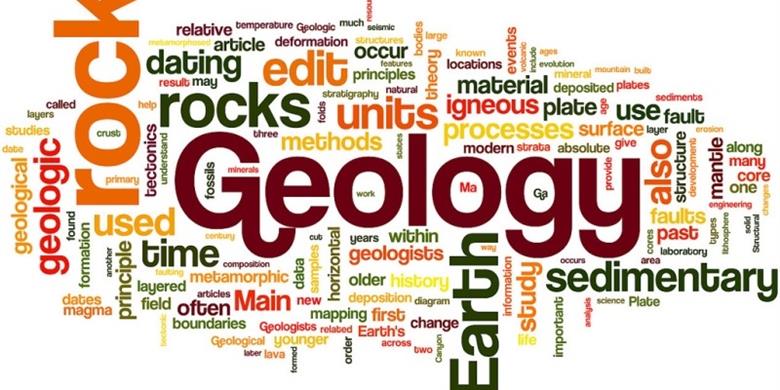Table of Contents
Hands-On Rocks
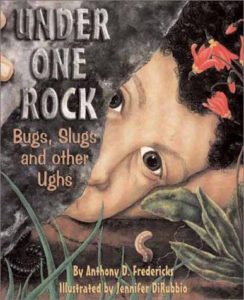
|
By Anthony D. Fredericks, Under One Rock (Dawn Publications, 2001) is a rhyming picture-book account of the ecosystems (“Bugs, Slugs, and Other Ughs”) to be found under rocks. An appendix of Field Notes provides more information on the creatures most likely to be found. Pair this one with an outdoor rock-turning expedition. For ages 4-8. |
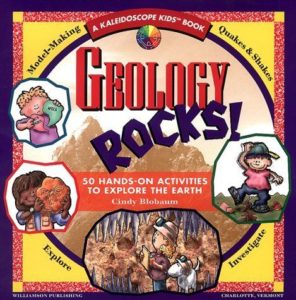
|
Cindy Blobaum’s Geology Rocks! (Williamson Publishing, 1999), subtitled “50 Hands-On Activities to Explore the Earth,” is a witty and informational collection covering everything from rock types to earthquakes and the structure of the planet. For example, try mining with a chocolate chip cookie, make a sand sculpture, play a rock version of Tic-Tac-Toe. Illustrated with a mix of cartoon drawings and photographs. For ages 7-12. |
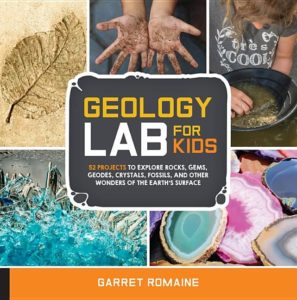
|
Garret Romaine’s Geology Lab for Kids (Quarry Books, 2017) has 52 experiments and projects for exploring crystals, volcanoes, rock types, earthquakes, geysers, fossils, space rocks, and more. For ages 8-12. |
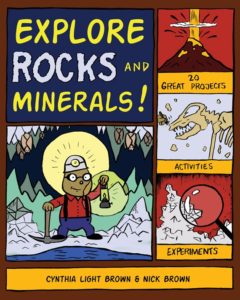
|
By Cynthia Light Brown, Explore Rocks and Minerals (Nomad Press, 2010) is a collection of 25 projects, activities, and experiments for rock lovers. Various chapters cover the structure of the earth, minerals and crystals, igneous, sedimentary, and metamorphic rocks, fossils, and rock collecting. Included are fact boxes and “Words 2 Know” lists. For example, kids make pumice (meringue) cookies, grow crystals and stalactites, make fossils, and more. For ages 8-12. |
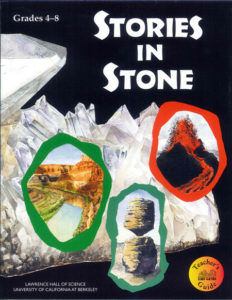 |
From the Lawrence Hall of Science GEMS (Great Explorations in Math and Science) program, see Stories in Stone, a creative 8-lesson, 164-page earth science unit for grades 4-8. (To accompany it, you’ll need a sample rock and mineral collection; sources are listed. Also see below.) Working with samples, kids differentiate between rocks and minerals, classify both, identify “mystery rocks,” experiment with crystals, and make clay models to study the rock cycle and plate tectonics. |
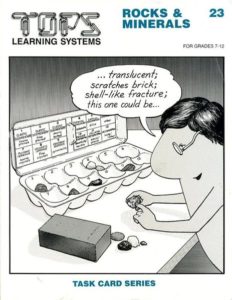
|
From TOPScience, Rocks and Minerals is an 88-page, activity-based study unit for grades 6-12 (or younger), variously covering types of rocks, Mohs hardness scale, rock identification, the rock cycle, and more. The TOPScience units are impressively clever, with detailed teaching tips, background information, and instructions for building your own sophisticated scientific equipment out of practically nothing. Highly recommended. |
| USGS Educational Resources has wonderful lesson plans, activity instructions, and downloadable teacher’s guides and student booklets on a wide range of environmental and earth science topics categorized by grade (K-2, 3-5, 6-8, and 9-12). | |
| Geology for Kids has interactive games, videos, lists of fun facts, and lesson plans. Kids can experiment online with rocks, minerals, and soils. Make quicksand and a vinegar volcano. | |
| Sponsored by the American Geosciences Institute, Earth Science Week has a long (long) alphabetized list of activities, categorized by grade level and based on the National Science Education Standards. Sample project titles: A Model of Three Faults, Chocolate Rock Cycle, Earthquake Machine, Geologic Age, Mud Fossils, and Rock Around the World. | |
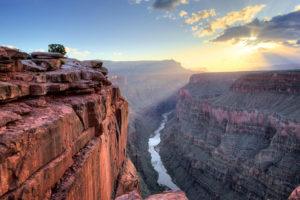 |
The Grand Canyon National Park Education page has lesson plans, virtual field trips, and distance learning opportunities. |
| Earth Learning Idea posts a new earth-related teaching idea or project every week. | |
| Discover with Dr. Cool science kits are terrific resources for young rock lovers. Among these: the Mine for Gems and Mine for Fossils kits, which come with digging tool, brush, and ten high-quality specimens embedded in a digging block; the Learn How to Pan for Gold kit, which has a prospector’s pan, mining tools, and two bags of “pay dirt” which contain – in lieu of actual gold – pyrite nuggets; and the Glow Rocks kit, which has a portable UV lamp, six fluorescent rock specimens, and an adventure guide. Very cool. | |
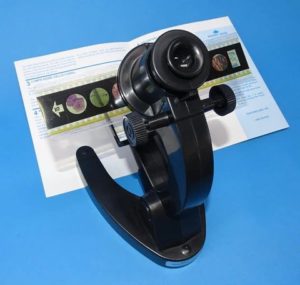 |
The Microslide Viewer is a truly terrific little apparatus – it looks a bit like a microscope (though is cheap, lightweight, washable, and pretty much indestructible) and can be used to view strips of photomicrographs (microslides), collections of eight or more photographs taken through microscopes at various degrees of magnification. There are dozens of microslide sets, among them “Rocks and Rock-Forming Minerals,” “Fossils,” and “Mineral Characteristics and Identification,” each a fascinating series of thin sections. (See granite, really close-up.) Viewers cost about $10; microslide sets about $6. Highly recommended. Available from a number of science suppliers. |
| 40 Playful Ways to Teach Young Kids About Rocks is a great collection of rock activities for the very young, including a make-your-own-rock activity, a percussion rock band project, a letter R craft (with rocks), and more. | |
| Home Science Tools carries a range of materials for geology fans, including rock and mineral collections, an earth cross-section model, soil test lab kits, gold panning gravel, and volcano kits. | |
| MiniMe Geology is a source for rock cycle, rock, and mineral kits, starter rock collections, individual rock and mineral samples, and geology equipment for rock hounds. Also at the site are a series of fascinating geology articles on a wide range of topics and an illustrated and annotated list of birthstones. | |
| Geology.com is a terrific source for information about geology and earth science, along with books, field guides, maps, and geology equipment (everything from rock hammers to gold pans). Click on Teacher Resources for an excellent collection of resources and activities, among them a plate tectonics animation, rock and mineral identification helps, information on buying and using a rock tumbler, and Adaptive Earth Science Activities, an 80-page printable booklet of geology and earth science projects, among them “Parking Lot Gravel,” “Spelunking,” “Rock Riddles,” “Mighty Metamorphic Power Rocks,” and “Modeling Geologic Columns with Sand Art.” For each are included a materials list, step-by-step instructions, and follow-up questions. | |
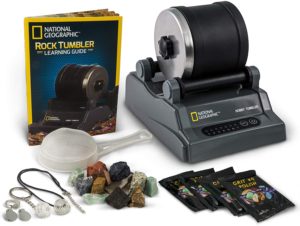 |
Polish rocks! Home Science Tools and other science supply sources carry rock tumblers, grit, and ready-to-polish rocks. |
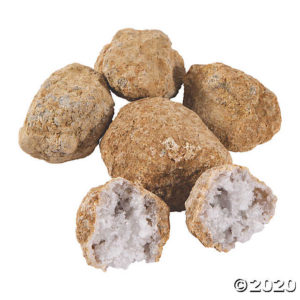 |
Break your own geodes! (Put them in a sock and smack them with a hammer to reveal an inner cavity filled with crystals.) Available from several sources; a box of twelve is available here. |
| For the dramatic geologist, Geology ROCKS! (Bad Wolf Press) is a 25-minute musical for elementary-level kids. The plot: Professor Rock has disappeared and his students head out on a quest to find him, with the dubious help of Sherlock Holmes and Doctor Watson. En route they encounter volcanoes and other geological features, and learn about the rock cycle. Script, teacher’s guide, and musical CD cost $39.95. | |
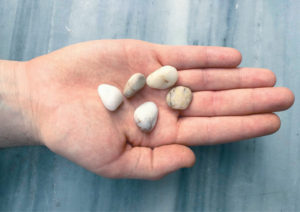 |
Five Stones is a game believed to have originated in ancient Asia. It’s like jacks, with a twist. All you need to play is hand-eye coordination and five small stones. Another reason to collect pebbles. |
